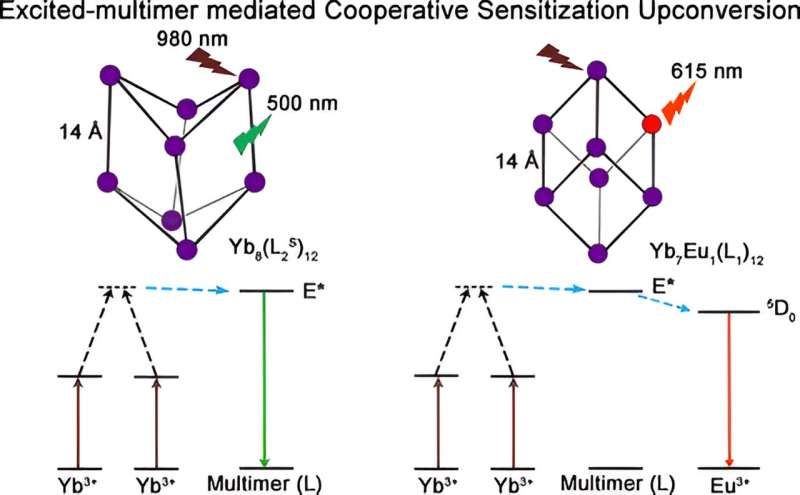This article has been reviewed according to Science X's editorial process and policies. Editors have highlighted the following attributes while ensuring the content's credibility:
fact-checked
peer-reviewed publication
trusted source
proofread
Excited-multimer mediated supramolecular upconversion on multicomponent lanthanide-organic assemblies

Upconversion (UC) luminescence is a process that converts low-energy photons into higher-energy ones with promising applications in diverse fields. However, known UC mechanisms mainly focus on the energy transfer processes between metal ions, while the role of organic ligands needs to be explored.
Lanthanide-organic assemblies constructed by coordination assembly have attracted great attention in supramolecular chemistry due to their wide applications in sensing, bioimaging, and cancer theranostics. However, limited by long-distance energy transfer of sensitizer and activator, achieving UC in multicomponent lanthanide-organic assemblies is very challenging.
In a study published in the Journal of American Chemical Society, the research group led by Prof. Sun Qingfu from Fujian Institute of Research on the Structure of Matter of the Chinese Academy of Sciences proposed excited-multimer mediated supramolecular UC on multicomponent lanthanide-organic assemblies.
The researchers found that subtle variation of ligand's peripheral substituents induced metal-centered stereoconfiguration control, and gave rise to two topological Ln8L12-type (Ln for lanthanide ion; L for organic ligand L1 or L2R/S) lanthanide-organic complexes. Nuclear magnetic resonance, electrospray ionization time-of-flight mass spectrometry, and X-ray crystallography confirmed the formation of rhombohedral Ln8(L1)12 and octahedral Ln8(L2R/S)12.
Photophysical studies on the lanthanide-organic assemblies showed highly efficient sensitized Eu3+, Sm3+, and Yb3+ for the homometallic Ln8L12 through the traditional antenna effect. Supramolecular lanthanide-organic assemblies of this pseudo-cube structure exhibited a rare example of assembly-induced excited-multimer states by suppressing intramolecular orientation and vibration.
Despite the large Ln···Ln distances (> 1.4 nm) in the complexes, the Yb8(L2)12 assembly showed unprecedented upconverted multimer green fluorescence (500 nm) under 980 nm excitation. A quadratic dependence of the UC intensity on the laser power density coincides with the expected two-photon UC mechanism. Moreover, the energies of excited-multimer states can be transferred to the partly doped Eu3+ ions in heterometallic (Yb/Eu)8L12 assemblies, realizing the upconverted red emissions of Eu3+ via excited-multimer-mediated cooperative sensitization UC.
The researchers observed no detectable Eu3+-centered UC emission in post-assembly mixtures of 7 equiv of Yb8L12 and 1 equiv of Eu8L12 under 980 nm excitation, confirming that the Yb3+ → Eu3+ energy transfer is an intramolecular rather than intermolecular UC process.
This study provides a new strategy for designing UC materials, which is crucial for exploiting photofunctions of multicomponent lanthanide-organic complexes.
More information: Xiao-Fang Duan et al, Excited-Multimer Mediated Supramolecular Upconversion on Multicomponent Lanthanide-Organic Assemblies, Journal of the American Chemical Society (2023). DOI: 10.1021/jacs.3c06775
Journal information: Journal of the American Chemical Society
Provided by Chinese Academy of Sciences





















